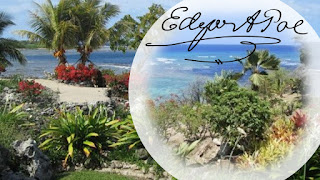Edgar Allan Poe’s postcard from the edge
A 24 year-old Edgar Allan Poe produces a competent and memorable poem that resonates with his oeuvre with his 1833 offering, “To One In Paradise.” The title is a double-entendre, the word “paradise” referring both to earthly delights as well as to the afterlife. The four-stanza poem explores familiar Poe themes, including a dead lover, a narrator fixated on the past, lost happiness, fatalism, and the allegorical use of natural place settings.
The aspect of the poem that merits our attention on first approach is its lovely, slender architecture, reminiscent of the Poe house on Amity Street in Baltimore, where the piece was written, while Poe lived there with his aunt Maria and his cousin Virginia. The top of the structure, the first stanza concerns the “earthly” paradise, while the last stanza looks to the afterlife. The first stanza gazes back longingly on the past, while the final stanza looks to the future with pathos and foreboding. Skillfully set in the middle, one quatrain reverses the overall pattern and looks to the past with gloom and to the future with transient, tragic hope.
Thou wast that all to me, love,
For which my soul did pine—
A green isle in the sea, love,
A fountain and a shrine,
All wreathed with fairy fruits and
flowers,
And all the flowers were mine.
The first stanza is a vision of bliss.
It could hardly be more splendid. The “green isle in the sea” recalls the
idyllic, seaside setting of the later “Annabel Lee” (1849) and the woodland setting of “Romance” (1829) (“a painted paroquet/Hath been—a most familiar bird”). It paints an Eden-like, primal paradise. We
are reminded of Poe’s English Romantic roots, and the emphasis on natural place
settings in his earlier poems like “The Lake” (1827) and “To The River ——” (1828). But even here we have some clues that all is
not well in paradise. First, it is written in the past tense. Second, we have
foreshadowing of the two themes: life and death, the here-now and the
hereafter. “A fountain” speaks to us of
life, but a “shrine” suggests death, a memorial; “fruits” sounds in life, but
“flowers” has ritual, spiritual connotations that point beyond life.
By the time we get to the last stanza,
we have left this “starry hope” far behind and we are looking toward a future
that entails all of the melancholy that comes with death and parting:
And all my days are trances,
And all my nightly dreams
Are where thy grey eye glances,
And where thy footstep gleams—
In what ethereal dances,
By what eternal streams.
Poe wraps up his fairly melodic poem
with a rhythmic crescendo—what I call a Poe ‘outro’ (meaning a repetitive
refrain to tie it all together at the end).
We see that the sentence structure becomes very drone (“And all my … / And all my … / Are
where thy … / And where thy … / In what … / By what …”). The monotony underscores the fatalism of the
sentiment, which laments that the star-crossed lovers will only be together in
“trances” and “dreams;” that the narrator will only glimpse the love of his
life in her “ethereal dances” and by “eternal streams.” The language foreshadows the desperate pining
of “Lenore” (1843) and
the aforementioned “Annabel Lee.”
But we also get a bridge in the third stanza which serves as an
inversion layer between the first and the last stanzas, reversing the thematic
structure—for a brief interlude—of both:
A voice from out the Future cries,
“On! on!”—but o’er the Past
(Dim gulf!) my spirit hovering
lies
Mute, motionless, aghast!
Do you see it? Whereas in the first and last stanza, the past
represents a perfect paradise and the future a dismal scenario, here, for a
brief, shining moment, the past is a “dim gulf” while the future is typified as
an encouraging voice that exhorts, “On! On!”
The above quatrain ends in the absolute surrender: “Mute, motionless
aghast!” The sentence right before, in
which the narrator’s “spirit hovering lies” brings to mind an out of body
experience, reminiscent of the one suggested in the first part of “For Annie” (1849). Then, we pass in the next stanza
to two unforgettable metaphors for the narrator’s crippled psyche: he is like
the “thunder-blasted tree” and the “stricken eagle” (once again, summoning
nature symbols, the inhabitants, perhaps, of the “green isle in the sea,” now neutralized).
So, all in all, not bad for a twenty-four year-old trying to cover
a vast expanse of the landscape of human pathos and pity.





Comments
Post a Comment